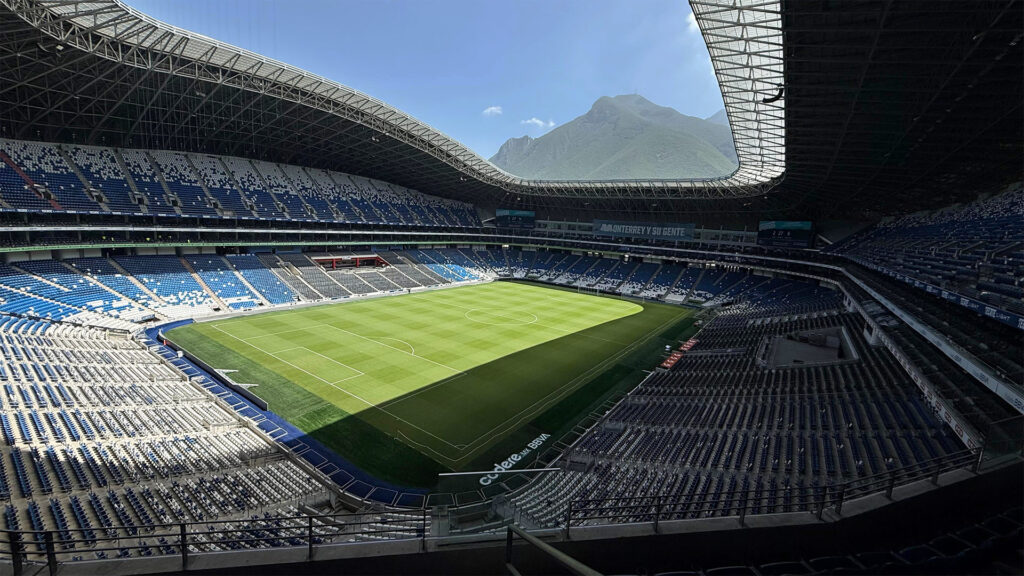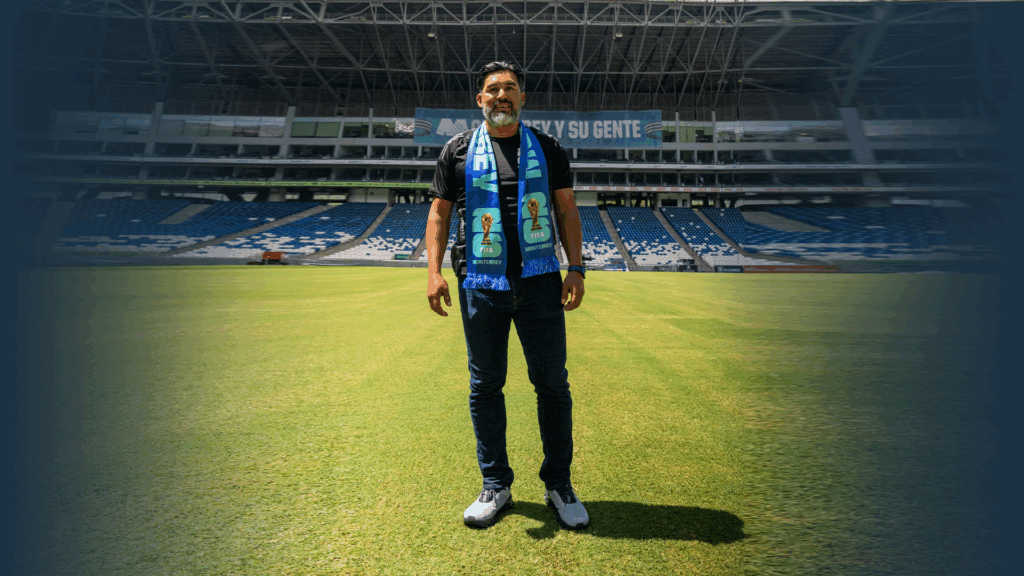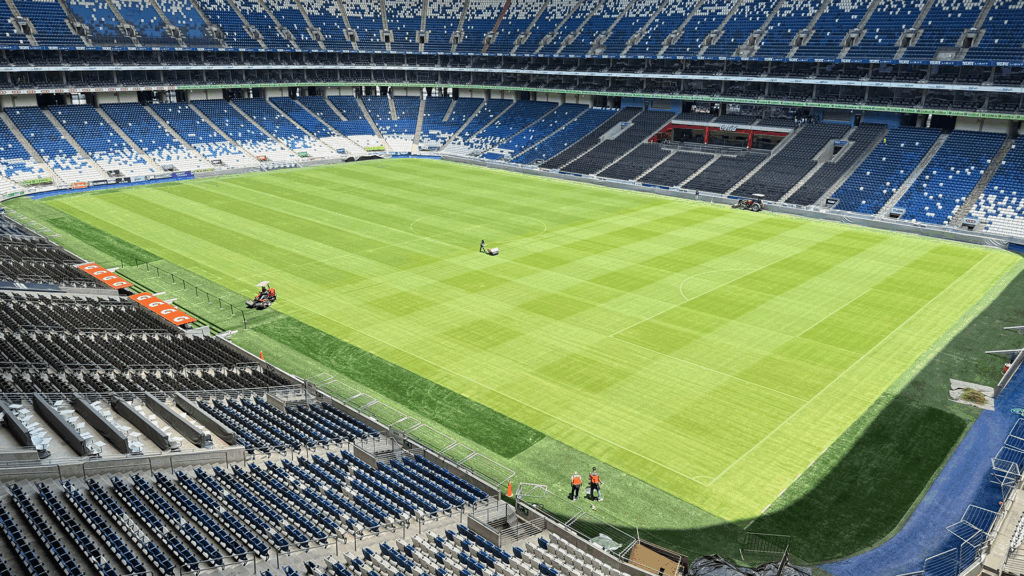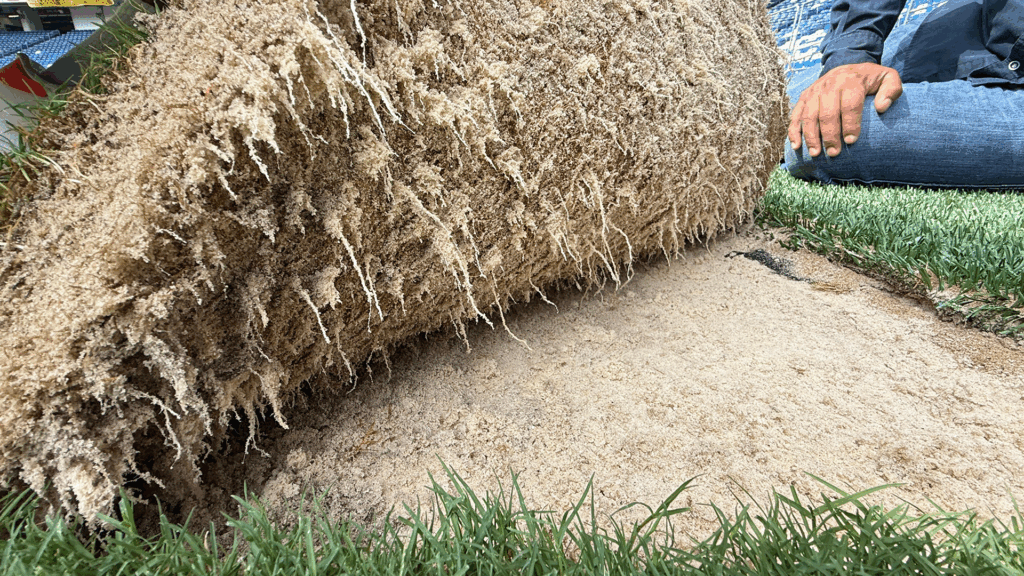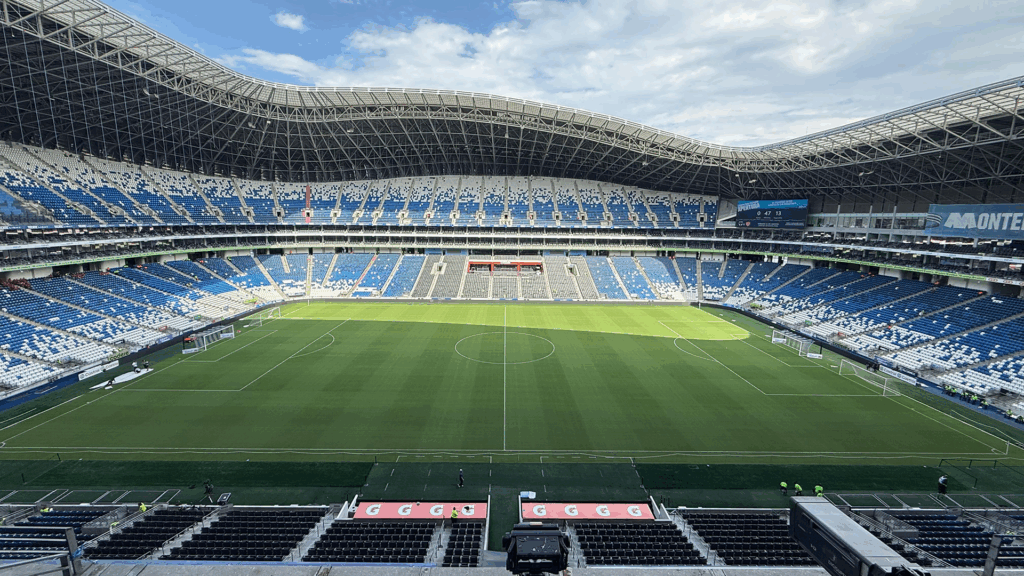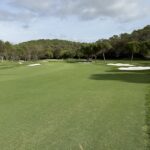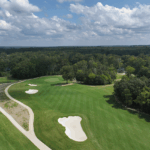PROJECT DETAILS
Facility:
Estadio BBVA, Monterrey, México. During the World Cup competition, the stadium will be temporarily renamed Stadium Monterrey to comply with FIFA sponsorship requirements.
Date:
July 2025
Location:
Monterrey, México
Fun Facts:
C.F. Monterrey holds the nickname Rayados, which refers to the club’s striped jerseys
About The Project
For more than two and a half years, Carlos Castillo, manager of the pitch and natural areas for Monterrey, Mexico’s Estadio BBVA, has gone to work each day with a singular focus. Ever since his facility was tapped to be one of only 16 stadiums to host the 2026 global football championships, Castillo’s driving thought has been to present “the best pitch in the World Cup.”
To make that goal a reality, Castillo, along with the C.F. Rayados leadership team and crew, undertook a renovation of the stadium’s pitch that included the installation of new sand subsurfaces and Tahoma 31 Bermudagrass sod.
Research & Testing
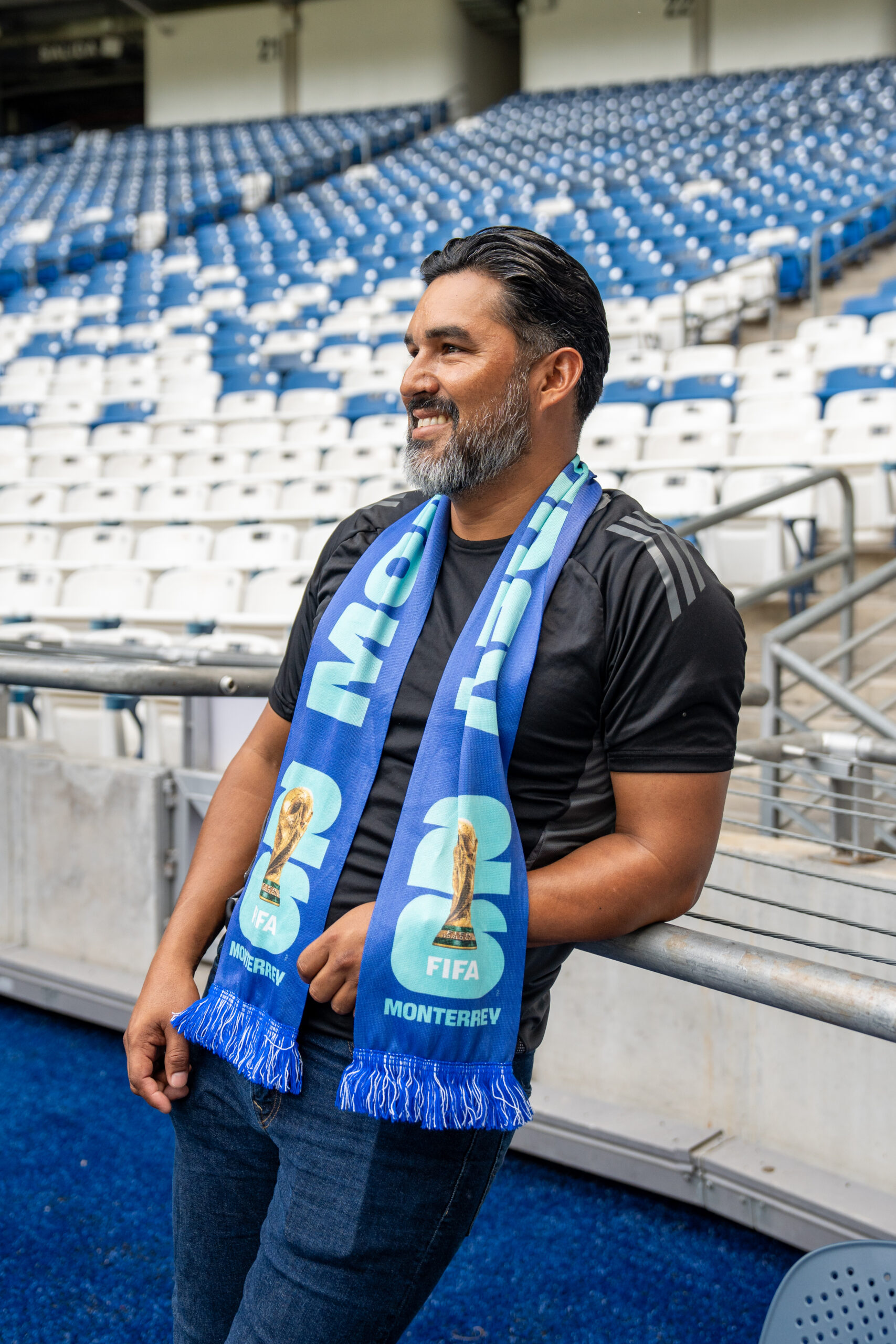 Before one roll of sod was laid, Castillo did meticulous research to determine the optimal turfgrass for the pitch. He consulted with FIFA’s agronomy team for guidance on their requirements. He studied university data and research reports on wear tolerance and wear recovery, cold tolerance, shade, turf quality, and water use. Beyond the written research materials, he spoke with other sports field managers in Spain and other countries who had Tahoma 31 on their pitches. He did his own research with Tahoma 31 and another variety under similar stadium conditions. Test after test, and under various stressors, Castillo says the Tahoma 31 outperformed the other variety in all the metrics important to him.
Before one roll of sod was laid, Castillo did meticulous research to determine the optimal turfgrass for the pitch. He consulted with FIFA’s agronomy team for guidance on their requirements. He studied university data and research reports on wear tolerance and wear recovery, cold tolerance, shade, turf quality, and water use. Beyond the written research materials, he spoke with other sports field managers in Spain and other countries who had Tahoma 31 on their pitches. He did his own research with Tahoma 31 and another variety under similar stadium conditions. Test after test, and under various stressors, Castillo says the Tahoma 31 outperformed the other variety in all the metrics important to him.
Before approving the installation, the Rayados management team asked Castillo why they should invest in Tahoma 31. His reply? “Because it’s the best.”
PROJECT DETAILS
Facility:
Estadio BBVA, Monterrey, México. During the World Cup competition, the stadium will be temporarily renamed Stadium Monterrey to comply with FIFA sponsorship requirements.
Date:
July 2025
Location:
Monterrey, México
Fun Facts:
C.F. Monterrey holds the nickname Rayados, which refers to the club’s striped jerseys
Cold Tolerance & Shade
The stadium sits in the shadow of a mountain, Cerro de la Silla (or Saddle Hill), that is visible from inside the stadium. Iconic views and a dramatic roof overhang give the facility a unique look and feel. The overhangs also throw a tremendous amount of shade on the pitch.
“We have a stadium for 53,000 people. So, we have a big cover. We have shade in the wings. We have a lot of shade. We have only four hours of sun in the summer on the pitch,” Castillo says.
To combat that challenge, Castillo felt he needed a bermudagrass that would offer not just shade tolerance but also cold tolerance, and early spring green-up attributes.
“The reason for the cold tolerance is to work together with the tolerance of the shade. That’s the biggest problem that we have,” Castillo says. Recovery from winter conditions was also a concern. He needed a grass that would “quickly wake up from the winter to the summer.” Early spring green-up was critical, which is a known attribute of Tahoma 31.
As for shade, it’s important to note that even though Tahoma 31ranked number one in National Turfgrass Evaluation Program (NTEP) trials for turf quality among major bermudagrass cultivars tested in up to 63% shade, the grass is still a bermudagrass and is not a shade-tolerant as, let’s say, a zoysiagrass. Yet Castillo is confident the combination of cold tolerance, spring green-up, and some shade tolerance offered him the best choice for a FIFA-approved bermudagrass variety.
Wear Tolerance & Pitch Hardness
Another issue Castillo wanted to address with the pitch renovation was to reduce the hardness of the surface. “In the past, we had weak grass, and it was very hard,” he says. With the old turf and subsurface profile, Gmax measurements hovered between 95 and 110. Post renovation, he saw an immediate improvement.
“With this change, we are in 65 to 70 in hardness,” Castillo says. “So that’s very good for the players,” who say that the pitch “feels more soft” which positively impacts both player safety and game performance.
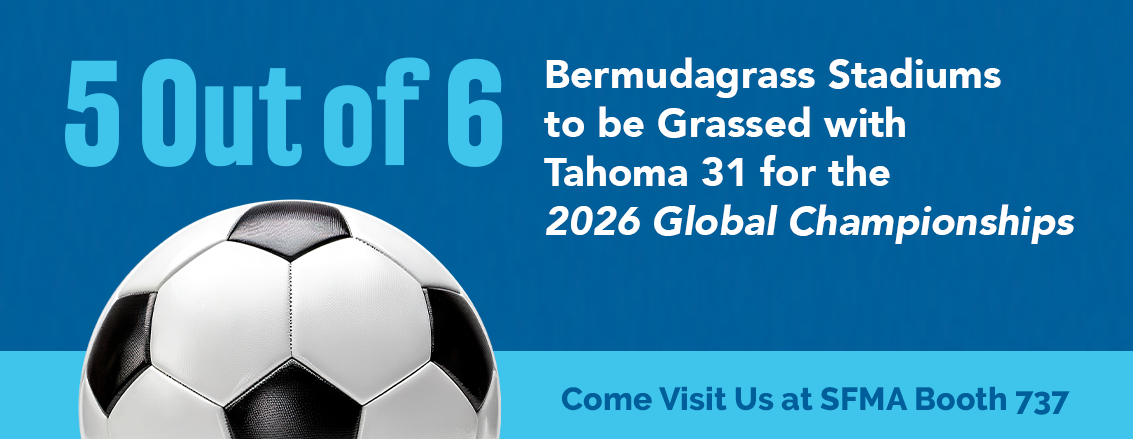
Show Time
After constructing a new pitch subsurface, on July 21, 2025, Tahoma 31 was installed as big roll sod. Four days later, the C.F. Monterrey Rayados team took to the pitch for training and then returned the next day with their first official match on the new grass. Castillo’s bosses, the team’s upper management, inspected the field after that first match. They noted the field’s tensile strength and durability. They had become believers.
“We have a good grass. A strong grass. And a good hardness. They are very happy,” Castillo says, with a smile. Following that first Friday practice and Saturday match, he marveled that there were “zero divots.”
Players have demonstrated their enthusiasm for the new pitch conditions in the most obvious way possible. “If we have a match on Saturday, they want to train here on Friday because they like the pitch. They want to stay here.”
As of this writing, and in accordance with FIFA’s natural grass regulations that ban artificial turf, it appears that of the 16 stadiums in the 2026 lineup, six will be grassed with warm-season bermudagrass. And of those six, five of the stadiums have chosen Tahoma 31. You read that correctly. Five out of six bermudgrass pitches are Tahoma 31. Castillo says he knows why.
“It’s the best,” he says.


